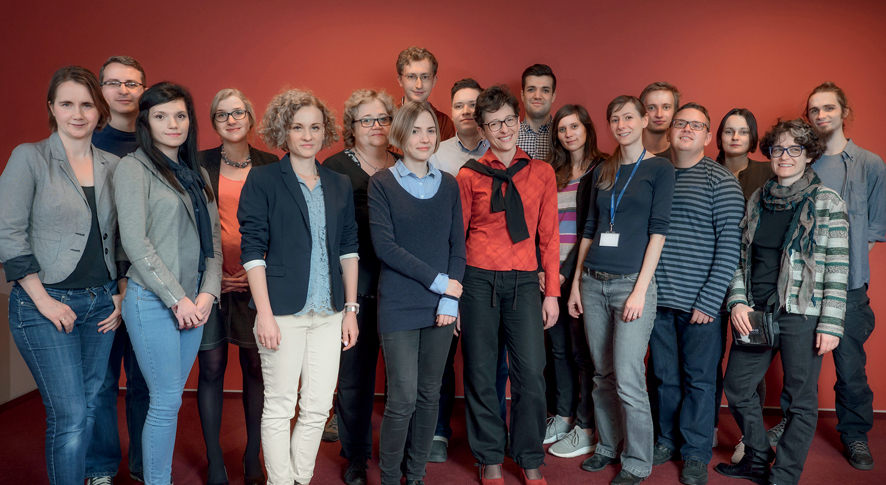- Head of laboratory
- Scientific Staff
- Technician and administration staff
- PhD Students
- Research profile
- Current research activities
- Selected publications
Head of laboratory

Research profile
Research activities of our laboratory are focused on the neurobiological basis of emo- tions. We are particularly interested in the mechanisms of socially transferred emotions (in rodent models of emotional contagion). Emotional contagion, i.e., the capacity to be affected by and/or share the emotional state of another individual, is considered to be the simplest form of empathy. In our laboratory we study neuronal circuits in the amygdala underlying social transfer of positive and negative emotions. In order to understand how the systems underlying social communication operate we employ rat and mouse mod- els, as well as neuronal tracing and optogenetic techniques. The two main questions our research is focused on are: (1) Are the neural circuits underlying positive and negative so- cial emotions distinct? (2) Does the social brain exist, i.e., are there neural circuits spe- cialized in social emotions? We also investigate the brain circuits and cellular mechanisms underlying impaired social interactions and the possibilities of therapeutic intervention in mouse genetic and idiopathic models of autism spectrum disorder. Using state-of- the-art automatic systems for assessing social behavior and neurobiology tools we try to explain why some individuals suffer from autism. Thalamo-Cortical Processing Group focuses on the effect emotional and cognitive state of the brain has on information processing within first and higher order thalamo-corti- cal pathways as well as the salience and valence of sensory stimuli.
Current research activities
- Socially transferred emotions – the neural basis of empathy. We investigate neural representations of emotional states in interacting animals using behavioral models of socially transferred positive and negative emotions designed in our laboratory
- Neural mechanisms of impaired social behaviors. Using high-throughput behavioral measures of social interactions we have developed (Eco-HAB system) we characterize neuronal circuits and cellular mechanisms underlying social interactions and validate tissue-specific therapeutic interventions using mouse models of synaptopathies rele- vant to autism spectrum disorders
- Social buffering. We are interested in the functional interplay between the prefrontal cortex, hippocampus, and amygdala resulting in fear contagion or social buffering effects
- Fear related activation of higher order thalamic pathways. We investigate whether overexcitation of the neural circuitry including cortex and amygdala underlies sensory related pathologies such as hypersensitivity in autism or hallucinations in schizophrenia
- EEG fingerprint of attention and executive control. By combining fMRI, EEG and novel analytical algorithms we search for distinct spatio-temporo-frequency patterns that specifically represent the level of activation of nodes of brain attentional networks in humans.
Selected publications
Meyza K.Z., Bartal I.B., Monfils M.H., Panksepp J.B., Knapska E. (2016) The roots of empathy: Through the lens of rodent models. Neurosci Biobehav Rev, pii: S0149-7634(15)30343-2. doi: 10.1016/j.neubiorev.2016.10.028.
Puścian A., Łęski S., Kasprowicz G., Winiarski M., Borowska J., Nikolaev T., Boguszewski P.M., Lipp H.P., Knapska E. (2016) Eco-HAB as a fully automated and ecologically relevant assessment of social mpairments in mouse models of autism Elife, 5. pii: e19532. doi: 10.7554/eLife.19532.
Mikosz M., Nowak A., Werka T., Knapska E. (2015) Sex differences in social modulation of learning in rats. Sci Rep, 5: 18114. Knapska E., Lioudyno V., Kiryk A., Mikosz M., Górkiewicz T., Michaluk P., Gawlak M., Chaturvedi M., Mochol G., Balcerzyk M., Wojcik D.K., Wilczynski G.M., Kaczmarek L. (2013) Reward learning requires activity of matrix metalloproteinase-9 in the central amygdala. J Neurosci, 33(36): 14591-14600.
Knapska E., Macias M., Mikosz M., Nowak A., Owczarek D., Wawrzyniak M., Pieprzyk M., Cymerman I.A., Werka T., Sheng M., Maren S., Jaworski J., Kaczmarek L. (2012) Functional anatomy of neural circuits regulating fear and extinction. Proc Natl Acad Sci U S A, 109(42): 17093-17098.
Sobolewski A., Kublik E., Świejkowski D.A., Kamiński J., Wróbel A. (2015) Alertness opens the effective flow of sensory information through rat thalamic posterior nucleus. Eur J Neurosci, 41: 1321-1331.

